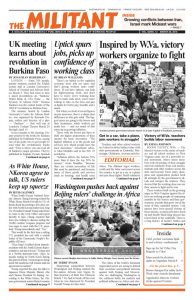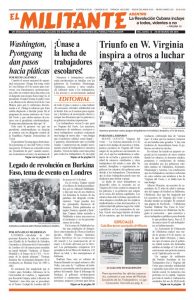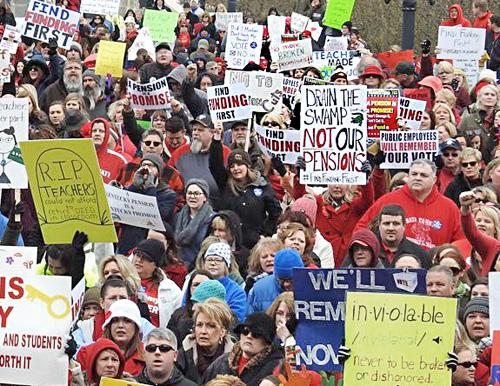BOONE COUNTY, W.Va. — The March 6 victory in the strike of teachers and all school workers in West Virginia came out of a powerful social movement, where union members took ownership of their struggle and won solidarity from coal miners, students and other workers across the state and beyond. Their unity, discipline and organization pushed back all attempts by the government to divide and conquer the workers. They showed that the working class can use their unions to fight and to win.
These workers built on the growing anger in West Virginia against the effects on working people of continuing assaults by the bosses and their government, assaults that grow out of the crisis of their capitalist system. Coal miners have been special victims of these attacks, as union jobs have dried up and deadly black lung disease has roared back in the coalfields. There is a long history of miners’ battles and use of their union, which the school workers used, holding “red shirt” days, the color the miners wore in some of their biggest battles. And a tradition of distrust of government at all levels.
Their victory has had a special impact on teachers in other states where their pay, health care, pensions and working conditions are set by the state government, including in Oklahoma, Kentucky, Mississippi and Arizona. Conditions facing school workers there mirror those in West Virginia, and strike talk is growing.
Alberto Morejon, a 25-year-old junior high school history teacher and junior varsity baseball coach in Stillwater, Oklahoma, says he was inspired by West Virginia teachers and decided to emulate their example. He started a Facebook page — “Oklahoma Teacher Walkout—The Time Is Now” — for teachers and other public workers to discuss what they could do. Some 65,000 workers have signed up as of March 12.
The Oklahoma Education Association union held a March 8 press conference, where Morejon spoke, and announced that unless the state government agrees to their demands they will go on strike April 2 and call for a mass protest at the Capitol that day.
A team of Socialist Workers Party members went to West Virginia to join in solidarity with the school workers and learn more about the growing social movement there. They joined protests in the capital, traveled around the state, and spent a day in three southern counties — McDowell, Wyoming and Boone.
Workers in the south — in the heart of West Virginia’s coal country — took the lead in getting the movement going. Back in November, they started building unity among members of the three unions — the West Virginia Education Association, the American Federation of Teachers-West Virginia and the West Virginia School Service Personnel Association. They mobilized for meetings and held “walk-ins,” gatherings outside schools to inform parents about the issues and protests they were planning.
On Feb. 2, workers in four southern counties got the “Blue Flu” and went to rally outside the Capitol in Charleston. And then the movement grew fast all over the state.
Students in Boone County stood up and made it clear that legislators couldn’t use them against the teachers. To make the point, they reached out to students across the state and organized more than 1,000 students to march in Charleston in solidarity with the strike March 2.
Influence of battles in the coalfields
Workers on the picket line make the point that students learned more from their strike and the discussions and organizing that prepared for it than anything in the classroom could have taught them. Many students volunteered for food packing and distribution operations with union members and others to provide meals for those who depend on the food they get in school.
Retired coal miner Fred Powers gave a history lesson to students and their families at the Bramwell Train Depot in nearby Mercer County. He told them about what conditions were like when he started working underground, using a mechanical canary in a cage to illustrate how they warned miners about rising methane levels.
“So long as the bird was singing, the air was safe, but if it stopped you’d better get out,” Powers said. “A canary cost a day’s pay and working days were often 12 to 14 hours.” Miners also liked rats for company, he said, because they too would alert miners, fleeing when they sensed the tunnel was becoming unsafe.
The influence of the history of the battles of coal miners marked the school workers’ fight. Workers wore red bandanas in honor of the historic coal miners’ war against local cops and company goons at Blair Mountain in 1921. Teachers and students discussed the bloody battle there, where thousands of armed miners took on machine guns and hired planes dropping tear gas and shrapnel. Because of their bandanas, the miners were called the “Red Neck Army.” Countless strikers and students here belong to coal mining families.
Steve White, a Boone County native and third-generation miner in his 40s, gave us a tour of the area around Bim, his home town.
“I worked underground for 17 years,” he said. “But I decided to quit for health reasons a couple years ago. My father died of black lung a short while back and I have the first symptoms of it myself.”
Southern West Virginia is where miners fought bloody battles to retake their union in the late 1960s and ’70s — a revolution in the United Mine Workers union to fight for miners’ right to safe working conditions with power to stop production when needed. Free health clinics were established throughout the region. Incidents of black lung declined more than 90 percent.
“Black lung never really went away and now it’s back,” said White. “People strongly support the teachers. We need a fight and we need a victory.” White’s wife Kim is a teacher’s assistant.
West Virginia has been ravished by the moral, political and economic crisis of capitalism today. Boone County, with a population of 25,000, has lost more than 5,000 mining jobs in the last half decade, with ripple effects on jobs, schools, social services, health care and retail.
As the union’s strength has waned, black lung has roared back, mainly in the southern counties, and is hitting younger miners. Under these conditions pain medication is widely available and southern West Virginia has one the country’s highest rates of opioid overdoses.
Coal mines are reopening
As White guides us along Route 85, we can see many abandoned mines, but we also see some that have reopened. “The one we just passed I didn’t even know about, it must have opened in the last few days,” White said.
“A lot of people here voted for Donald Trump,” he continued. “Clinton said we were ‘deplorables,’ while he talked about the carnage and beautiful coal and said jobs would come back.”
“The strike comes from the same place,” Emily Comer, a teacher in Kanawha County, told a March 10 meeting in New York. “It comes from a place of economic desperation. That’s why people voted for Trump and that’s why people went on strike.”
And for the same reason, workers don’t trust the government. Gov. Jim Justice announced Feb. 27 that he was going to get strikers a 5 percent raise and their union officials said they should go back to work. Strikers used their union — they convened local meetings in all 55 counties, debated it, and voted to stay out on strike. “We don’t trust the legislature,” they said. Their strike stayed solid and nine days later they won.


